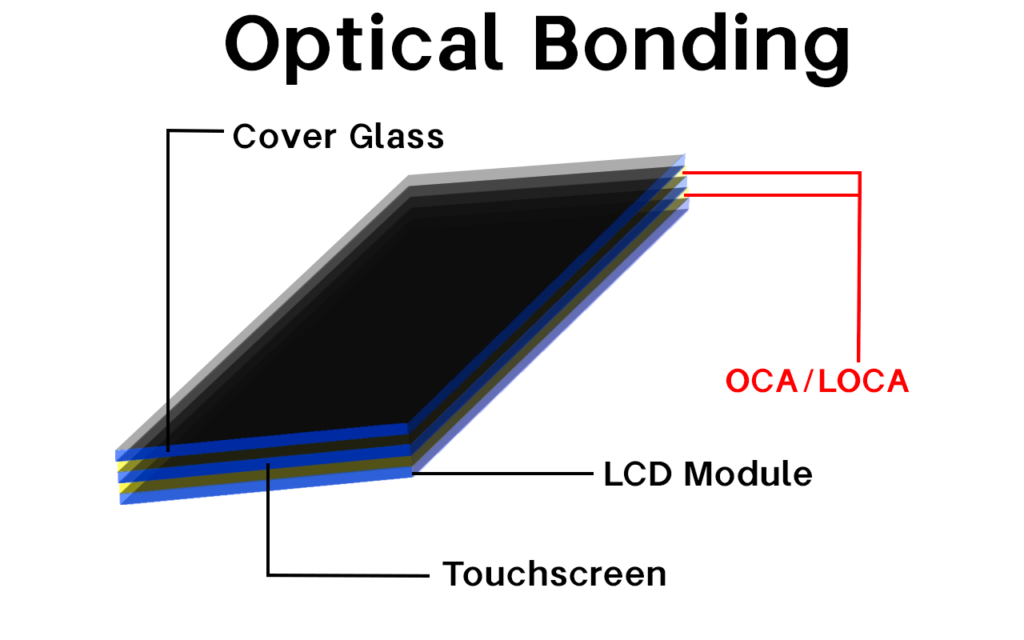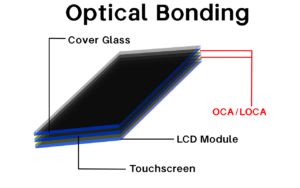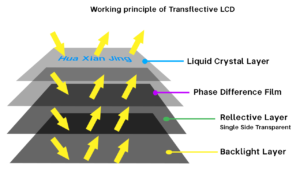Bonding technology plays a crucial role in many display systems, particularly in touchscreens and LCDs. This technology facilitates the joining of multiple layers, such as the touch screen to the LCD or the LCD to the backlight. Two main types of bonding technology are commonly used: air bonding and optical bonding.
1. What is Air Bonding Technology?

Air bonding technology, also known as frame bonding, bonds two flat panels by applying bonding glue only to the edges. This method creates an air gap between the layers. Air bonding is the more traditional and cost-effective option in bonding technology.
Hua Xian Jing‘s modern factory uses a fully automatic production line, and the yield rate of air bonded products can reach up to 99%.
Key Features of Air Bonding Technology:
- Advantages:
- Low cost: As one of the oldest bonding technologies, air bonding is economical.
- Fast production speed: The process is simple and highly scalable.
- High yield rate: It is less prone to production errors, resulting in a high rate of usable products.
- Easy to repair: In case of damage, the repair process is relatively straightforward.
- Disadvantages:
- Display issues: The air gap between layers can cause a decrease in color accuracy and contrast, resulting in a less vibrant display.
- Dust and moisture: The air gap makes it easier for dust and moisture to penetrate the display, which can reduce the product’s lifespan.
- Weaker durability: Air bonding provides less impact resistance compared to other bonding methods.
2. What is Optical Bonding?

Optical bonding technology involves using a transparent adhesive to fully bond the display’s layers, eliminating the air gap. This adhesive, known for its excellent light transmittance, is evenly applied to bond the layers together seamlessly. The result is a stronger, more durable display with enhanced visual quality.
Optical bonding is divided into two categories based on the type of adhesive used:
- Optical transparent adhesive (OCA)
- Liquid optical transparent adhesive (LOCA)
2.1 Optical Transparent Adhesive (OCA)
OCA is a pre-processed adhesive film that is consistently applied between the layers. It offers advantages in mass production, as the film is uniform in thickness and can be easily applied.
- Advantages:
- Consistency: Uniform thickness makes the process highly predictable.
- Ease of production: Suitable for large-scale manufacturing, as it does not require complex adjustments.
- Disadvantages:
- Size limitations: OCA films must be cut to specific sizes, which can limit flexibility in some designs.
2.2 Liquid Optical Transparent Adhesive (LOCA)
LOCA is applied in liquid form, which allows for greater flexibility in filling gaps and accommodating irregular surfaces.
- Advantages:
- Gap filling: LOCA is ideal for bonding uneven or non-flat surfaces.
- Size versatility: It is not restricted by size, making it useful for displays of varying dimensions.
- Disadvantages:
- Production complexity: Precise control over the amount of adhesive is required.
- Slower production: The process takes longer compared to using OCA, due to the challenges in handling the liquid material.
3. Air Bonding vs. Optical Bonding
| Feature | Air Bonding Technology | Optical Bonding Technology |
|---|---|---|
| Cost | Low | High |
| Production Speed | Fast | Slower |
| Yield Rate | High | Low |
| Visual Quality | Color and contrast issues due to air gap | Improved color, contrast, and readability |
| Durability | Weaker impact resistance, prone to dust/moisture | Stronger, impact-resistant, prevents dust/moisture |
| Repairability | Easier to repair | Difficult to repair due to full-layer bonding |
Conclusion
Air bonding is best suited for applications where cost efficiency and high production speeds are priorities, such as in mass production of budget-friendly devices. However, its limitations in terms of display quality and durability make it less desirable for high-performance devices.
Optical bonding, on the other hand, provides superior durability and visual performance by eliminating the air gap. It is favored in industries where display readability, impact resistance, and moisture protection are critical, but its higher cost and complexity make it a less frequent choice for budget-sensitive projects.
FAQ
Is optical bonding a zero-bonding technology?
Yes, optical bonding is considered a zero-bonding technology because it creates a seamless fit between the touch screen and the display, leaving no air gap between the layers.
What are the working conditions of the bonding glue used in optical bonding?
The working temperature range of the bonding glue used by Hua Xian Jing on its products is -20°C to 70°C, and we also support customized LCD display modules for extreme working conditions.
What materials are used in optical bonding glue?
The commonly used materials for optical bonding glue include:
- Acrylic fiber: Used in some optical bonding applications for its clarity and durability.
- Silicone: Known for flexibility and resistance to extreme temperatures.
- Optically transparent resin (LOCA): Used in liquid optical bonding, providing excellent transparency and the ability to bond irregular surfaces effectively.





